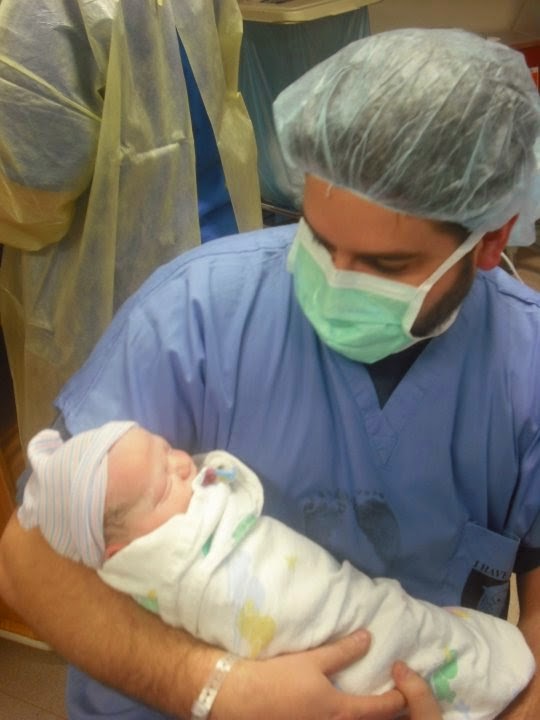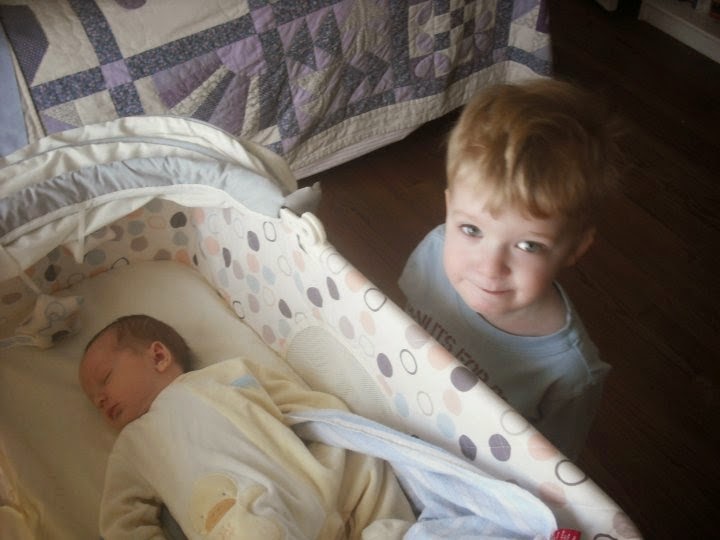I knew I wanted to nurse (breastfeed) long before I had children. My mother talked glowingly about her experiences as a nursing mother, and she often touted the mental and physical health benefits for mother and child. Before my first son was born, we registered for a few nursing-friendly bottles and a basic pump, but we had no plans to buy or use formula. I took breastfeeding classes before he was born and welcomed a lactation consultant who worked at the hospital. Like many new mothers, it took the baby and me a few days to get the hang of it, but we did. By the time we went home, we both felt like we knew what we were doing. I kept nursing him for 19 months, and he weaned naturally. I felt like the poster child for the La Leche League. I never imagined even having to resort to a lactation consultant.
 |
|
| My newborn with his amazing daddy. |
So you can imagine my shock when about one week after my second son was born, I found myself pumping every two hours around the clock; trying desperately and unsuccessfully to get him to latch; feeding him from a bottle against my better judgment; and on the verge of giving up. How did I get to this point? How did I go from a nursing superstar to an emotional train wreck with engorged breasts and an angry baby?
 |
| Two weeks old, with nursing problems mostly behind us. |
It wasn’t anyone’s fault. He was a little more challenging than the first one, but by the second day we were starting to get the hang of it. And then on Day 3, he started having seizures. He was already jaundiced, which made him tired and cranky (and thus difficult to nurse). The jaundice plus the seizures plus the medicine given to stop the seizures meant that he fell asleep on Day 3 and stayed asleep for the next 36 hours.Suddenly he was taken out of my room and rushed to the NICU for the next two days. He had to have a feeding tube put in, and I pumped regularly to supply him with my milk while he recovered. When he woke up, he was dazed and lethargic. The progress we’d made on learning to latch had disappeared. The only way he could eat was from a hospital bottle; anything else was too difficult and frustrating for him. The hospital’s lactation consultant assured me that he would learn to latch again in a few days, if I used a nipple shield. I tried, and he tried, and we went home together at midnight on Day 5.We kept trying, and I kept pumping. Every two hours I went through the same cycle: try to nurse, with no success; end up using the bottle; pump for the next round; wash out the bottle and pump; and rest for an hour or less before starting again. I was also recovering from a C-section, so I was not in the best physical shape, either. I called the hospital and talked to one of their lactation consultant, and she told me what I’d already heard: keep using the nipple shield, and he’ll get it eventually. My mother was in town to help me, and she and my husband kept me sane by understanding my desire to nurse but also helping me not feel like a failure for the problems I was having. Like fellow blogger Rachael, I found that having a support system was crucial during that first week.
When I Found MY Lactation Consultant
But we were making zero progress. I was getting tired of the hand pump, so I looked into renting a slick automatic pump like the one I’d used in the hospital. I used the International Lactation Consultant Association website to find a nurse, Wendy, who rented the machines privately, at lower rates than our hospital. I told her I needed a pump, and instead of asking me how long I needed it, she simply asked, “Why?” So I told her the whole story, bursting into tears as I outlined my frustration and exhaustion. She said, “Come over tomorrow, and in one hour, we’ll teach that baby to latch.”
I was delighted to hear this, but I worried about the cost. Renting the machine was cheap. An hour with a private lactation consultant cost about $100. I was not working at the time, and money was tight. But my husband pointed out that we could easily spend $100 in just one month on formula. He also knew how important nursing was to me and understood my desire to keep trying.
We made the appointment and drove up with the baby the next day. I was excited but skeptical; my husband was supportive and kind, as he’d been during this whole process. Wendy told me what I already suspected, which is that nipple shields are not an effective way to teach a baby to latch, unless you have a genuine medical need for them (such as inverted nipples). Instead, she showed me a few methods for “latch-training.” She explained that the baby had to learn how to manipulate his mouth, because nursing and bottle feeding are completely different. So she had me put my index finger in his mouth, with the pad of my finger gently touching the roof of his mouth. Sure enough, he sucked with a newborn’s frenzy. After a few minutes, she had me switch from finger to nipple. It took a few tries, but by the end of the hour, he latched on for the first time in days. I cannot describe the relief and happiness I felt.
It took about another week to get him to nurse 100% of the time. In the meantime, we used the finger-training method. We also got a FirstYears Breastflow bottle, which at the time was the only bottle designed for nursing babies. (Plenty of bottles are labeled “nursing,” but they operate like a normal bottle. This one would only give milk if he shaped his mouth and sucked as if he was nursing. So it also trained him how to nurse.) We got into a newer, better cycle: finger-train; attempt to nurse; feed with the bottle; attempt to nurse again. Slowly he was spending less time with the bottle and more time nursing. Eventually I was able to nurse him without needing the training steps at all; he’d finally gotten it.
My consultant had other methods up her sleeve, too, but the finger-training worked the best for us. The main difference between seeing a private lactation consultant and one at the hospital was time. The women at the hospital meant well, but they were clearly overbooked. They would sweep in, spend about 5 minutes showing me a few holds and techniques, and then sweep out. They were often impatient with me when I didn’t “get it” the first time, which just made me feel worse. My first son and I managed anyway because we didn’t have any problems to work through. With the second one, however, we needed more: more time, more patience, and more solutions beyond pumps and nipple shields. The private nurse got to know our family and our baby; she was calm and comforting instead of brisk and demanding; and she offered a variety of solutions that were simple and cheap.
My sons are now 6 and 4, and my nursing days are far behind me. But I look back on those days with love and nostalgia. Nursing my babies helped us bond and kept them healthy during the first year and beyond. The problems I experienced were temporary, and it was all well worth it in the long run. My second experience as a mother would have been much more difficult without Wendy’s help. So during World Breastfeeding Week, I’m celebrating nursing moms, but I’m also honoring the partners and professionals that have helped us along the way: thank you.
Let’s connect on social, too:
Mumbling Mommy on Facebook
Mumbling Mommy on Twitter
Mumbling Mommy on Pinterest
Tags: breastfeeding








